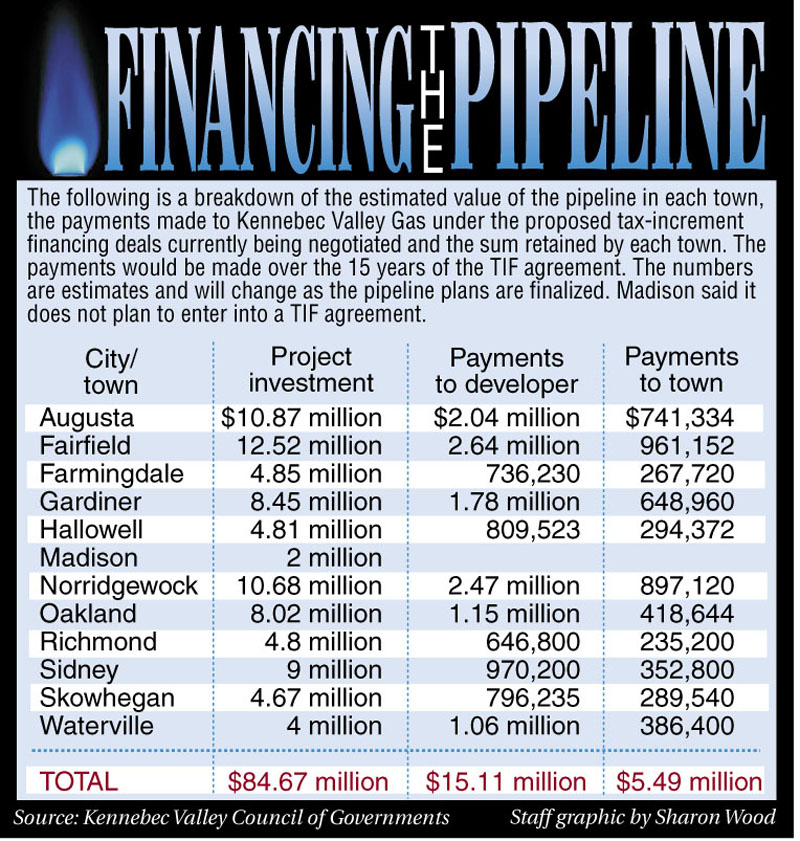A company that wants to build a natural gas pipeline in central Maine needs three industrial plants to agree to buy the gas in order to make building the line economically feasible.
But Kennebec Valley Gas Co.’s $85 million project with about 120 miles of underground main and distribution lines also hinges on the decisions of residents and officials in a dozen towns and cities.
Ultimately, the likelihood that the project will be completed is not only up to major users of natural gas but individual voters across Sagadahoc, Kennebec and Somerset counties who will decide whether to support the possible development through tax increment financing districts.
It’s a scenario with many moving parts, as each community has its own concerns, timeline, procedures and desired locations for the pipeline.
The construction would start in Richmond, where the line would connect to the Maritimes and Northeast natural gas pipeline already built between Nova Scotia and Massachusetts. Then the new line would travel north through Gardiner, Farmingdale, Hallowell, Augusta, Sidney, Oakland, Waterville, Fairfield, Skowhegan and Norridgewock, and end in Madison.
For some communities, it could be their first tax increment financing deal. One town, Madison, does not plan to approve a TIF district. Augusta was the first and is still the only municipality to have approved it.
The TIF districts would allow the municipalities to redirect a percentage of the new property taxes generated by the pipeline back to the developer to help the project’s financing. The districts also act as a tax shelter, so increased property values in a specified area don’t result in increased tax commitments. Communities can use the percentage of new property taxes they keep for economic development.
The TIF agreements are essential for Kennebec Valley Gas’ project financing and must be completed before the company can solidify its cost structure. While there is no drop-dead date for the towns to finalize TIF agreements, the company can’t negotiate and sign contracts with users until the TIF agreements are lined up.
“We can’t lock things down finally until we know what we have from the towns in terms of the TIFs. That’s why we would like to move this along as rapidly as possible,” said Richard Silkman, a principal of Kennebec Valley Gas.
The TIF agreements, which would last 15 years, are essential because they would provide the company with a way to meet its debt obligations during the first years when businesses are switching their heating systems to natural gas, Silkman said.
While the large industrial users, such as Huhtamaki Packaging in Waterville and Fairfield, Sappi Fine Paper in Skowhegan and Madison Paper Industries, would likely switch as soon as the line was operational, it would probably take years for smaller users to convert their systems. In that time, the company would still have to pay its loans.
“It’s just that it will take some time for them to switch. During that time when they are switching, we still have debt service costs to pay for,” Silkman said.
Under the proposed TIF agreement, 80 percent of new property taxes the first 10 years would return to the developer and 20 percent to the towns. In years 11 through 15, 60 percent would return to the developer and 40 percent to the towns.
After that, the communities would keep 100 percent of the tax revenue, throughout the useful life of the pipeline.
Silkman declined to provide specific financial numbers but said the company originally asked for a 100 percent return the first 10 years. It settled on 80 percent. But, for example, a 50 percent return would not have worked financially, he said.
The company has met three or four times with each community, he said, and is working to satisfy their needs while maintaining the balance of supply, demand and economic feasibility.
“In many of the towns they have identified areas they would like us to get to if we can, and we’re working on getting there,” Silkman said.
Madison has said no to a TIF, but it’s possible the town could build its own distribution system, collect revenues from it and pay tariffs to Kennebec Valley Gas, Silkman said.
“If Madison decided that it didn’t want a TIF, but it did want to build out its own system, that from our perspective is an ideal situation, and we would welcome that,” he said.
Erin Rhoda — 612-2368
erhoda@centralmaine.com
Copy the Story Link
Send questions/comments to the editors.



Success. Please wait for the page to reload. If the page does not reload within 5 seconds, please refresh the page.
Enter your email and password to access comments.
Hi, to comment on stories you must . This profile is in addition to your subscription and website login.
Already have a commenting profile? .
Invalid username/password.
Please check your email to confirm and complete your registration.
Only subscribers are eligible to post comments. Please subscribe or login first for digital access. Here’s why.
Use the form below to reset your password. When you've submitted your account email, we will send an email with a reset code.